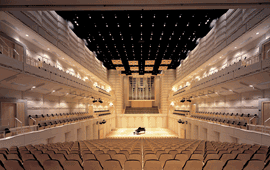> [Archived] Chronicles

Notes on... A Musical Journey - Dortmund, Oldenburg and Back (I)
At the Opera there were general rehearsals with The Marriage of Figaro by Mozart, the ninth of the fifteen premieres (opera, operetta and ballet) scheduled for the season. Regarding the cast, the only sure names are the artists interpreting the couple the Count - the Countess of Almaviva; for the other main characters, two different casts are available. The soloists, most of them young and with good voices, convey the impression that they know perfectly well what they have to do, even if not all of them manage that all the time. Among the cast at the premiere, I was delighted to see again the very young Romanian mezzo-soprano Ileana Mateescu. A former student of Maria Slatinaru, having perfected her art at Mozarteum - Salzburg, she embodies Cherubino in this performance, with a perfect voice range and irresistible acting talent.
Under the baton of the conductor Jac van Steen, the progress from one rehearsal to the next is impressive, especially when it comes to the co-ordination between what happens in the pit and on the stage. The Dortmund Philharmonic Orchestra - with a permanent symphony season besides the performances at the Opera - functions like a well designed and maintained mechanism which, with the proper lead, has the expected output.
What is really fascinating is the production, in co-operation with the Nuremberg State Theatre. The vision of the director Mariame Clément, modern in the best sense of the term, is ingeniously brought to life, with minimalistic means. The costumes and the furniture respect the period, but for the cinema-like sequence of the frames, the emphasis on the characters and their relationships, unconventional solutions are found. The stage depicts Count Almaviva's residence, with all its rooms and chattels. There are no walls except in the second act, whose action takes place entirely in the Countess' chamber. As for the rest, some significant furniture item suggests the place and at the same time, presents the characters, each one in their own milieu and with their own status. For example, when the curtain is lifted at the beginning, a bed stands for the Countess' boudoir, where she (not actually present during the first act) receives the visit of doctor Bartolo who consults her and writes a prescription; a piano stands for the 'music chamber' and Don Basilio is, of course, in front of the keyboard; a cupboard, a table, a clothes line indicate the servants' quarters. Someone is always present, something happens all the time; a silent animation of dark silhouettes against a bright background, reminding of the engravings in Mozart's period. Everything changes its place all the time, as if in a dance of lights and shades, so that the protagonists of the moment are in the limelight. It is then when their silhouettes acquire relief and colour, get their voices. This idea is maintained until the end, but the few décor elements either disappear or become simpler, stimulating the onlooker's fantasy. The action is fluent, full of artlessness and humour, the four acts being grouped together, two by two.
It will be quite the premiere.
22nd February
Still in Dortmund, I watched Der Traum der Roten Kammer - The Dream of the Red Chamber, a ballet on music chosen from the creation of the contemporary British composer Michael Nyman; a modular, repetitive, minimalist music, mainly chamber music, with interesting violin, flute and piano solos, but having also some in tutti sonorous peaks, really dramatic. The performance was conducted by the Japanese Motonori Kobayashi - conductor in residence at the Dortmund Opera - and the leading lady was the Romanian ballerina Monica Fotescu, more supple and graceful than ever. She has been the prima ballerina of this company for ten years, but lately she has also become known for the choreographies she signs both here and in Romania. The scenario for the ballet The Dream of the Red Chamber, created by Christian Baier, is based on China's cultural tradition and history, from the emperors' period to our days. The beauty of the costumes and the expressiveness of the décor to which some very adequate projections were added in key-moments increased the effect of the music and of the dance on the spectators, bringing also the 'local colour' that neither the composition nor the choreography had emphasized. The latter was created by the Chinese choreographer Xin Peng Wang, who has led the troupe for almost a decade. Under his leadership, the Dortmund Ballet has gained a privileged position and managerial autonomy in relation to the other compartments of the theatre, becoming soon the most appreciated by the audience. The ballet performances are sold out, the tickets being purchased months in advance.
The house was packed for The Dream of the Red Chamber, too.
Translated by Mihaela Olinescu and Elena Daniela Radu
MTTLC, Bucharest University














